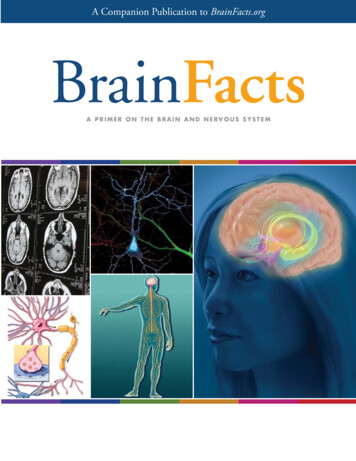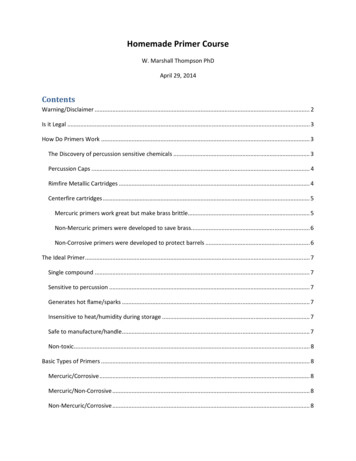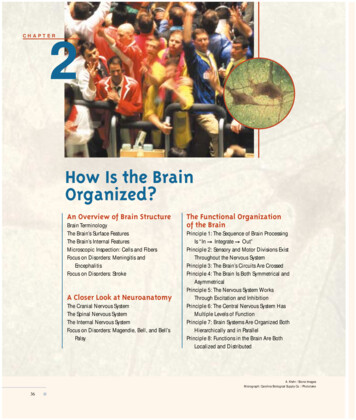
Transcription
A Companion Publication to BrainFacts.orgA PRIMER ON THE BRAIN AND NERVOUS SYSTEM
A PRIMER ON THE BRAIN AND NERVOUS SYSTEMA companion to BrainFacts.orgA PUBLIC INFORMATION INITIATIVE OF:
P r e fa c eOver the past two decades, scientific knowledge about the structure and function of the brain andnervous system and understanding of brain-based disorders have increased exponentially. Neuroscientistsare using remarkable new tools and technologies to learn how the brain controls and responds to the body,drives behavior, and forms the foundation for the mind. Research is also essential for the development oftherapies for more than 1,000 nervous system disorders that affect more than 1 billion people worldwide.As these strides occur, it is crucial that scientists communicate with the general public, helpingstudents, teacher, parents, medical caregivers, policymakers, and others stay informed of developments inneuroscience. In particular, students — the scientists, policymakers and scientifically literate citizens of thefuture — need access to clear, easy-to-use information on this important topic.As part of its enduring commitment to public education and outreach, the Society for Neuroscience(SfN) is pleased to present the seventh edition of Brain Facts: A Primer on the Brain and NervousSystem. This edition has been substantially revised. Research progress has been updated throughout thepublication, and a new section on animal research added. The information also has been reorganized intosix sections to make it easier for readers to glean the “big ideas” covered, and the specific topics that fallunder each category.The publication of the Brain Facts seventh edition coincides with the launch of BrainFacts.org,a public information initiative of The Kavli Foundation, The Gatsby Charitable Foundation, andSfN. BrainFacts.org brings to digital life the historic Brain Facts book, and augments it with hundredsof additional, scientifically vetted public information resources available from leading neuroscienceorganizations worldwide. BrainFacts.org is envisioned as a dynamic and unique online source forauthoritative public information about the progress and promise of brain research. It will be updatedfrequently with the latest neuroscience information from around the globe, while the Brain Facts book willcontinue to be a vital teaching and outreach tool.We encourage you to visit BrainFacts.org frequently to supplement information found within thiscompanion book, and to join us in the quest for continuing revolutionary advances in understanding thebrain and mind.2Society for NeuroScieNce
coNteNtSN NtSIntroduction . 4Part 1: Introduction to the BrainChapter 1: Brain Basics . 6Chapter 2: The Developing Brain . 13Part 2: Sensing, Thinking, and BehavingChapter 3: Senses and Perception . 18Chapter 4: Learning, Memory, and Language . 25Chapter 5: Movement. 29Chapter 6: Sleep . 32Part 3: Across the LifespanChapter 7: Stress . 36Chapter 8: Aging . 39Part 4: Brain ResearchChapter 9: Kinds of Research . 42Part 5: Diseases and DisordersChapter 10: Childhood Disorders . 49Chapter 11: Addiction . 52Chapter 12: Degenerative Disorders . 57Chapter 13: Psychiatric Disorders . 62Chapter 14: Injury and Illness . 66Part 6: Treating Brain DisordersChapter 15: Potential Therapies . 73Chapter 16: Neuroethics . 76Glossary . 80Neuroscience Resources . 86Index . 88Society for NeuroScieNce3
iNtroductioNThe huMAN BRAIN — a spongy, threepound mass of tissue — is the most complex living structurein the universe. With the capacity to create a networkof connections that far surpasses any social network andstores more information than a supercomputer, the brainhas enabled humans to achieve breathtaking milestones —walking on the moon, mapping the human genome, andcomposing masterpieces of literature, art, and music. What’smore, scientists still have not uncovered the extent of whatthe brain can do. This single organ controls every aspectof our body, ranging from heart rate and sexual activity toemotion, learning, and memory. The brain controls theimmune system’s response to disease, and determines, in part,how well people respond to medical treatments. Ultimately,it shapes our thoughts, hopes, dreams, and imaginations. It isthe ability of the brain to perform all of these functions thatmakes us human.Neuroscientists, whose specialty is the study of thebrain and the nervous system, have the daunting task ofdeciphering the mystery of how the brain commands thebody. Over the years, the field has made enormous progress.For example, neuroscientists now know that each personhas as many as 100 billion nerve cells called neurons, andthe communication between these cells forms the basis of allbrain function. However, scientists continue to strive for adeeper understanding of how these cells are born, grow, andorganize themselves into effective, functional circuits thatusually remain in working order for life.The motivation of researchers is to further ourunderstanding of human behavior, including how we readand speak and why we form relationships; to discover waysto prevent or cure many devastating disorders of the brain aswell as the body under the brain’s control; and to advancethe enduring scientific quest to understand how the worldaround us — and within us — works.The importance of this research cannot be overstated.More than 1,000 disorders of the brain and nervous systemresult in more hospitalizations than any other disease group,including heart disease and cancer. Neurological illnessesaffect more than 50 million Americans annually andcost more than 500 billion to treat. In addition, mental4BraiN factS introductiondisorders strike 44 million adults a year at a cost of 148billion. Advances in research could reduce these costs. Forexample, discovering how to delay the onset of Alzheimer’sdisease by five years could save 50 billion in annual healthcare costs.In the past two decades, neuroscience has madeimpressive progress in many of the field’s key areas. Now,more than ever, neuroscience is on the cusp of majorbreakthroughs.Recently, significant findings have been documented inthe following areas.Genetics Disease genes have been identified thatare key to several disorders, including the epilepsies,Alzheimer’s disease, Huntington’s disease, Parkinson’s disease,and amyotrophic lateral sclerosis (ALS). These discoverieshave provided new insight into underlying diseasemechanisms and are beginning to suggest new treatments.With the mapping of the human genome, neuroscientistshave been able to make more rapid progress in identifyinggenes that either contribute to or directly cause humanneurological disease. Mapping animal genomes has aidedthe search for genes that regulate and control manycomplex behaviors.Gene-environment Interactions Most majordiseases have a genetic basis strongly influenced by theenvironment. For example, identical twins, who share thesame DNA, have an increased risk of getting the samedisease compared with nonidentical siblings. However, ifone twin gets the disease, the probability the other willalso be affected is between 30 percent and 60 percent,indicating that there are environmental factors at playas well. Environmental influences involve factors such asexposure to toxic substances, diet, level of physical activity,and stressful life events.Brain Plasticity The brain possesses the abilityto modify neural connections to better cope with newcircumstances. Scientists have begun to uncover themolecular basis of this process, called plasticity, revealinghow learning and memory occur and how declines mightbe reversed. In addition, scientists have discovered thatthe adult brain continually generates new nerve cells — aSociety for NeuroScieNce
process known as neurogenesis. Interestingly, one of the mostactive regions for neurogenesis in the brain, the hippocampus,is also an area heavily involved in learning and memory.New Therapies Researchers have gained insightinto the mechanisms of molecular neuropharmacology, orhow drugs affect the functioning of neurons in the nervoussystem, providing a new understanding of the mechanisms ofaddiction. These advances have also led to new treatmentsfor depression and obsessive-compulsive disorder. Inaddition, neuroscientists have discovered that many of thetoxic venoms used by animals can be adapted into newpharmacological treatments. For example, the poison of apuffer fish, tetrodotoxin (TTX), halts electrical signaling innerve cells. However, in discrete, targeted doses, TTX can beused specifically to shut down those nerve cells involved insending constant signals of chronic pain.Imaging Revolutionary imaging techniques,including positron emission tomography (PET), functionalmagnetic resonance imaging (fMRI), and optical imaging withweak lasers, have revealed the brain systems underlyingattention, memory, and emotions. These techniques alsohave pointed to dynamic changes that occur in schizophreniaand other disorders.Cell Death Two major advances in neuroscience —the discovery of how and why neurons die, along with thediscovery of stem cells, which divide and form new neurons— have many clinical applications. These findings havedramatically improved the chances of reversing the effectsof injury in both the brain and the spinal cord. The firsteffective treatments for stroke and spinal cord injury based onthese advances are under study.Brain Development New understanding of brainfunction, as well as newly discovered molecules responsiblefor guiding nervous system development, have givenscientists greater insight into certain disorders of childhood,such as cerebral palsy. Together with the discovery of stemcells, these advances are pointing to novel strategies forhelping the brain or spinal cord regain functions lost as aresult of injury or developmental dysfunction.Society for NeuroScieNceThis book provides a glimpse of what is known aboutthe nervous system, the disorders of the brain, and someof the exciting avenues of research that promise newtherapies for many neurological diseases. In the yearsahead, neuroscience research funded by public and privatesupport will continue to expand our knowledge of how thisextraordinary organ and the entire nervous system function.introduction BraiN factS5
chaPhaPterter 1:BraiN BaSicSinthischapternAnatomy of the Brain and theNervous SystemnThe NeuronnNeurotransmitters andNeuromodulatorsAnatomy of the Brain and the Nervous SystemThe brain is the body’s control center, managing justabout everything we do. Whether we’re thinking, dreaming,playing sports, or even sleeping, the brain is involved insome way. A wonder of evolutionary engineering, the brainis organized into different parts that are wired together ina specific way. Each part has a specific job (or jobs) to do,making the brain the ultimate multitasker. Working intandem with the rest of the nervous system, the brain sendsand receives messages, allowing for ongoing communication.Mapping the Brain The cerebrum, the largestpart of the human brain, is associated with higher orderfunctioning, including the control of voluntary behavior.Thinking, perceiving, planning, and understanding languageall lie within the cerebrum’s control. The cerebrum is dividedinto two hemispheres — the right hemisphere and theleft hemisphere. Bridging the two hemispheres is a bundleof fibers called the corpus callosum. The two hemispherescommunicate with one another across the corpus callosum.Covering the outermost layer of the cerebrum is asheet of tissue called the cerebral cortex. Because of its graycolor, the cerebral cortex is often referred to as gray matter.The wrinkled appearance of the human brain also can beattributed to characteristics of the cerebral cortex. More thantwo-thirds of this layer is folded into grooves. The groovesincrease the brain’s surface area, allowing for inclusion ofmany more neurons.The function of the cerebral cortex can be understoodby dividing it somewhat arbitrarily into zones, much like thegeographical arrangement of continents.6BraiN factS introductionto the brainThe frontal lobe is responsible for initiating andcoordinating motor movements; higher cognitive skills, suchas problem solving, thinking, planning, and organizing; andfor many aspects of personality and emotional makeup.The parietal lobe is involved with sensory processes,attention, and language. Damage to the right side ofthe parietal lobe can result in difficulty navigating spaces,even familiar ones. If the left side is injured, the ability tounderstand spoken and/or written language may be impaired.The occipital lobe helps process visual information,including recognition of shapes and colors.The temporal lobe helps process auditory information andintegrate information from the other senses. Neuroscientistsalso believe that the temporal lobe has a role to play inshort-term memory through its hippocampal formation, and inlearned emotional responses through its amygdala.All of these structures make up the forebrain. Otherkey parts of the forebrain include the basal ganglia, which arecerebral nuclei deep in the cerebral cortex; the thalamus; andthe hypothalamus. The cerebral nuclei help coordinate musclemovements and reward useful behaviors; the thalamus passesmost sensory information on to the cerebral cortex afterhelping to prioritize it; and the hypothalamus is the controlcenter for appetites, defensive and reproductive behaviors, andsleep-wakefulness.The midbrain consists of two pairs of small hills calledcolliculi. These collections of neurons play a critical rolein visual and auditory reflexes and in relaying this type ofinformation to the thalamus. The midbrain also has clustersof neurons that regulate activity in widespread parts of thecentral nervous system and are thought to be important forreward mechanisms and mood.The hindbrain includes the pons and the medullaoblongata, which control respiration, heart rhythms, andblood glucose levels.Another part of the hindbrain is the cerebellumwhich, like the cerebrum, also has two hemispheres. Thecerebellum’s two hemispheres help control movement andcognitive processes that require precise timing, and also playan important role in Pavlovian learning.The spinal cord is the extension of the brain through thevertebral column. It receives sensory information from all partsSociety for NeuroScieNce
small concentrations of gray matter called ganglia, aterm specifically used to describe structures in the PNS.Overall the nervous system is a vast biological computingdevice formed by a network of gray matter regionsinterconnected by white matter tracts.The brain sends messages via the spinal cord toperipheral nerves throughout the body that serve tocontrol the muscles and internal organs. The somaticnervous system is made up of neurons connecting theCNS with the parts of the body that interact withthe outside world. Somatic nerves in the cervicalregion are related to the neck and arms; those inthe thoracic region serve the chest; and those in thelumbar and sacral regions interact with the legs.The autonomic nervous system is made of neuronsconnecting the CNS with internal organs. It is dividedinto two parts. The sympathetic nervous system mobilizesenergy and resources during times of stress and arousal,while the parasympathetic nervous system conserves energyand resources during relaxed states, including sleep.Messages are carried throughout the nervoussystem by the individual units of its circuitry: neurons.The next section describes the structure of neurons,how they send and receive messages, and recentdiscoveries about these unique cells.The top image shows the four main sections of the cerebral cortex: the frontal lobe, theparietal lobe, the occipital lobe, and the temporal lobe. Functions such as movement arecontrolled by the motor cortex, and the sensory cortex receives information on vision,hearing, speech, and other senses. The bottom image shows the location of the brain’smajor internal structures.of the body below the head. It uses this information for reflexresponses to pain, for example, and it also relays the sensoryinformation to the brain and its cerebral cortex. In addition,the spinal cord generates nerve impulses in nerves that controlthe muscles and the viscera, both through reflex activities andthrough voluntary commands from the cerebrum.The Parts of the Nervous System The forebrain,midbrain, hindbrain, and spinal cord form the centralnervous system (CNS), which is one of two great divisionsof the nervous system as a whole. The brain is protected bythe skull, while the spinal cord, which is about 17 inches (43cm) long, is protected by the vertebral column.The other great division of the human brain is theperipheral nervous system (PNS), which consists of nerves andSociety for NeuroScieNceThe NeuronCells within the nervous system, called neurons,communicate with each other in unique ways. Theneuron is the basic working unit of the brain, aspecialized cell designed to transmit informationto other nerve cells, muscle, or gland cells. In fact,the brain is what it is because of the structuraland functional properties of interconnected neurons. Themammalian brain contains between 100 million and 100billion neurons, depending on the species. Each mammalianneuron consists of a cell body, dendrites, and an axon. The cellbody contains the nucleus and cytoplasm. The axon extendsfrom the cell body and often gives rise to many smallerbranches before ending at nerve terminals. Dendrites extendfrom the neuron cell body and receive messages from otherneurons. Synapses are the contact points where one neuroncommunicates with another. The dendrites are covered withsynapses formed by the ends of axons from other neurons.When neurons receive or send messages, they transmitelectrical impulses along their axons, which can rangeintroduction to the brain BraiN factS7
Nerve impulses involve the opening andclosing of ion channels. These are selectivelypermeable, water-filled molecular tunnels thatpass through the cell membrane and allowions — electrically charged atoms — or smallmolecules to enter or leave the cell. The flow ofions creates an electrical current that producestiny voltage changes across the neuron’s cellmembrane.The ability of a neuron to generate anelectrical impulse depends on a difference incharge between the inside and outside of thecell. When a nerve impulse begins, a dramaticreversal in the electrical potential occurs on thecell’s membrane, as the neuron switches from aninternal negative charge to a positive charge state.The change, called an action potential, then passesalong the axon’s membrane at speeds up to severalhundred miles per hour. In this way, a neuronmay be able to fire impulses multiple times everysecond.When these voltage changes reachthe end of an axon, they trigger the releaseof neurotransmitters, the brain’s chemicalmessengers. Neurotransmitters are released atnerve terminals, diffuse across the synapse, andbind to receptors on the surface of the targetcell (often another neuron, but also possibly amuscle or gland cell). These receptors act as onThe nervous system has two great divisions: the central nervous system (CNS), which consists ofthe brain and the spinal cord, and the peripheral nervous system (PNS), which consists of nerves and-off switches for the next cell. Each receptorand small concentrations of gray matter called ganglia. The brain sends messages via the spinalhas a distinctly shaped region that selectivelycord to the body’s peripheral nerves, which control the muscles and internal organs.recognizes a particular chemical messenger. Aneurotransmitter fits into this region in muchin length from a tiny fraction of an inch (or centimeter)the same way that a key fits into a lock. Whento three feet (about one meter) or more. Many axons arethe transmitter is in place, this interaction alters the targetcovered with a layered myelin sheath, which accelerates thecell’s membrane potential and triggers a response from thetransmission of electrical signals along the axon. This sheathtarget cell, such as the generation of an action potential, theis made by specialized cells called glia. In the brain, the gliacontraction of a muscle, the stimulation of enzyme activity,that make the sheath are called oligodendrocytes, and in theor the inhibition of neurotransmitter release.peripheral nervous system, they are known as Schwann cells.An increased understanding of neurotransmitters inThe brain contains at least ten times more glia thanthe brain and knowledge of the effects of drugs on theseneurons. Glia perform many jobs. Researchers have knownchemicals — gained largely through animal research —for a while that glia transport nutrients to neurons, cleancomprise one of the largest research efforts in neuroscience.up brain debris, digest parts of dead neurons, and help holdScientists hope that this information will help themneurons in place. Current research is uncovering importantbecome more knowledgeable about the circuits responsiblenew roles for glia in brain function.for disorders such as Alzheimer’s and Parkinson’s diseases.8BraiN factS introductionto the brainSociety for NeuroScieNce
Sorting out the various chemical circuits isvital to understanding the broad spectrum ofthe brain’s functions, including how the brainstores memories, why sex is such a powerfulmotivation, and what makes up the biologicalbasis of mental illness.There are many different kinds ofneurotransmitters, and they all play an essentialrole in the human body. The next sectionprovides a summary of key neurotransmittersand neuromodulators, chemicals that help shapeoverall activity in the brain.Neurotransmitters andNeuromodulatorsAcetylcholine The first neurotransmitterto be identified — about 80 years ago — wasacetylcholine (ACh). This chemical is releasedby neurons connected to voluntary muscles,causing them to contract, and by neurons thatcontrol the heartbeat. ACh is also a transmitterin many regions of the brain.ACh is synthesized in axon terminals.When an action potential arrives at the nerveterminal, electrically charged calcium ionsrush in, and ACh is released into the synapse,where it attaches to ACh receptors on the targetcells. On voluntary muscles, this action openssodium channels and causes muscles to contract.ACh is then broken down by the enzymeNeurons are cells within the nervous system that transmit information to other nerve cells, muscle,or gland cells. Most neurons have a cell body, an axon, and dendrites. The cell body containsacetylcholinesterase and resynthesized in thethe nucleus and cytoplasm. The axon extends from the cell body and often gives rise to manynerve terminal. Antibodies that block onesmaller branches before ending at nerve terminals. Dendrites extend from the neuron cell bodytype of ACh receptor cause myasthenia gravis,and receive messages from other neurons. Synapses are the contact points where one neurona disease characterized by fatigue and musclecommunicates with another. The dendrites are covered with synapses formed by the ends ofaxons from other neurons.weakness.Much less is known about ACh in theblocks of proteins. Certain amino acids can also serve asbrain. Recent discoveries suggest that it may beneurotransmitters in the brain. The neurotransmitterscritical for normal attention, memory, and sleep. Becauseglycine and gamma-aminobutyric acid (GABA) inhibit theACh-releasing neurons die in Alzheimer’s patients, findingfiring of neurons. The activity of GABA is increased byways to restore this neurotransmitter is a goal of currentbenzodiazepines (e.g., valium) and by anticonvulsant drugs.research. Drugs that inhibit acetylcholinesterase — andIn Huntington’s disease, a hereditary disorder that beginsincrease ACh in the brain — are presently the main drugsduring midlife, the GABA-producing neurons in brainused to treat Alzheimer’s disease.centers that coordinate movement degenerate, causingAmino Acids Amino acids, widely distributeduncontrollable movements. Glutamate and aspartate act asthroughout the body and the brain, serve as the buildingexcitatory signals, activating, among others, N-methyl-dSociety for NeuroScieNceintroduction to the brain BraiN factS9
aspartate (NMDA) receptors which, in developing animals,have been implicated in activities ranging from learningand memory to development and specification of nervecontacts. The stimulation of NMDA receptors may promotebeneficial changes in the brain, whereas overstimulation cancause nerve cell damage or cell death. This is what happensas a result of trauma and during a stroke. Developingdrugs that block or stimulate activity at NMDA receptorsholds promise for improving brain function and treatingneurological and psychiatric disorders.Catecholamines The term catecholamines includesthe neurotransmitters dopamine and norepinephrine.Dopamine and norepinephrine are widely present in thebrain and peripheral nervous system. Dopamine is presentin three principal circuits in the brain. The dopaminecircuit that regulates movement has been directly linkedto disease. Due to dopamine deficits in the brain, peoplewith Parkinson’s disease show such symptoms as muscletremors, rigidity, and difficulty in moving. Administration oflevodopa, a substance from which dopamine is synthesized,is an effective treatment for Parkinson’s, allowing patients towalk and perform skilled movements more successfully.Another dopamine circuit is thought to be important forcognition and emotion; abnormalities in this system have beenimplicated in schizophrenia. Because drugs that block certaindopamine receptors in the brain are helpful in diminishingpsychotic symptoms, learning more about dopamine isimportant to understanding mental illness. In a third circuit,dopamine regulates the endocrine system. Dopamine directsthe hypothalamus to manufacture hormones and hold them inthe pituitary gland for release into the bloodstream or to triggerthe release of hormones held within cells in the pituitary.Deficiencies in norepinephrine occur in patients withAlzheimer’s disease, Parkinson’s disease, and Korsakoff’ssyndrome, a cognitive disorder associated with chronicalcoholism. These conditions all lead to memory loss and adecline in cognitive functioning. Thus, researchers believethat norepinephrine may play a role in both learning andmemory. Norepinephrine is also secreted by the sympatheticnervous system throughout the body to regulate heartrate and blood pressure. Acute stress increases release ofnorepinephrine from sympathetic nerves and the adrenalmedulla, the innermost part of the adrenal gland.Serotonin This neurotransmitter is present in thebrain and other tissues, particularly blood platelets and the10BraiN factS introductionto the brainlining of the digestive tract. In the brain, serotonin has beenidentified as an important factor in sleep quality, mood,depression, and anxiety. Because serotonin controls differentswitches affecting various emotional states, scientists believethese switches can be manipulated by analogs, chemicalswith molecular structures similar to that of serotonin. Drugsthat alter serotonin’s action, such as fluoxetine, relievesymptoms of depression and obsessive-compulsive disorder.Peptides Short chains of amino acids that are linkedtogether, peptides are synthesized in the cell body and greatlyoutnumber the classical transmitters discussed earlier. In1973, scientists discovered receptors for opiates on neuronsin several regions of the brain, suggesting that the brain mustmake substances very similar to opium. Shortly thereafter,scientists made their first discovery of an opiate peptideproduced by the brain. This chemical resembles morphine,an opium derivative used medically to kill pain. Scientistsnamed this substance enkephalin, literally meaning “inthe head.” Soon after, other types of opioid peptideswere discovered. These were named endorphins, meaning“endogenous morphine.” The precise role of the naturallyoccurring opioid peptides is unclear
This book provides a glimpse of what is known about the nervous system, the disorders of the brain, and some of the exciting avenues of research that promise new therapies for many neurological diseases. In the years ahead, neuroscience research funded by public and private











